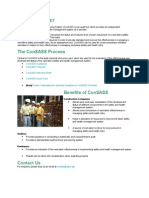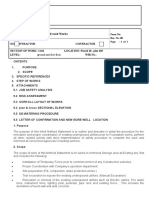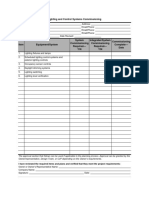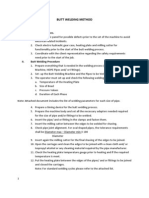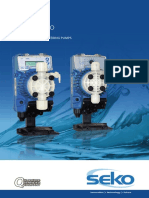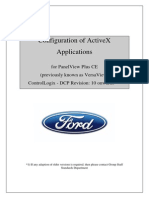Piping and Instrumentation Diagrams (P&Id) Engineering Drawings Interpretation
Piping and Instrumentation Diagrams (P&Id) Engineering Drawings Interpretation
Uploaded by
Mariesta AriantiCopyright:
Available Formats
Piping and Instrumentation Diagrams (P&Id) Engineering Drawings Interpretation
Piping and Instrumentation Diagrams (P&Id) Engineering Drawings Interpretation
Uploaded by
Mariesta AriantiOriginal Description:
Original Title
Copyright
Available Formats
Share this document
Did you find this document useful?
Is this content inappropriate?
Copyright:
Available Formats
Piping and Instrumentation Diagrams (P&Id) Engineering Drawings Interpretation
Piping and Instrumentation Diagrams (P&Id) Engineering Drawings Interpretation
Uploaded by
Mariesta AriantiCopyright:
Available Formats
Effective J anuary 1, 2014
www.acm.ca
#700, 940 - 6th Ave SW
Calgary, Al berta Canada T2P 3T1
Ph: 403.264.9637 Fax: 403.264.6671
Page 1 of 3
PIPING AND INSTRUMENTATION DIAGRAMS (P&ID)
ENGINEERING DRAWINGS INTERPRETATION
Course Fee: $1,495 CDN per student
The course fee includes registration, lunch and refreshments, and course materials. Price is exclusive of applicable taxes. Courses
held in the U.S are billed in U.S. dollars.
The Board of Canadian Registered Safety Professionals (BCRSP) reviewed this course and has
accepted it and granted it 0.5 CMP (Certification Maintenance Program) credit. Canadian Registered
Safety Professionals (CRSP) that take our course may claim 0.5 CMP.
BUILDING A SOLID FOUNDATION
Safety issues, design/installation defects and mal-operation all have a financial impact that can be greatly
reduced by properly training employees who have a solid foundation in the fundamentals of P&ID
interpretation.
COURSE TESTIMONIALS
Here are a few quotes from over 400 students weve trained in the last two years;
My first time involved with this level of detail in a P&ID and it was very informative. Great
course. I learned a lot. A must for anyone using P&IDs.
The extensive field experience of the instructor really impressed me. Great teacher. Very
knowledgeable.
I feel I learned a lot of new concepts. I would recommend this training.
BENEFITS OF PIPING AND INSTRUMENTATION DIAGRAMS (P&ID) PROGRAM
This course will provide employees with the ability to understand how the facilities relate to the
drawings so that they can focus on improvements.
Accurate drawings and the ability to read and understand these drawings are a requirement for
the analysis of emergency situations and the assessment of safety, environmental and regulatory
compliance issues such as Process Hazards Analysis / HAZOP studies.
This course will also provide engineers dealing with Management of Change the ability to speak
the same language as the operators of the facilities.
It will form the foundation for base level learning and will provide consistent and improved
communications between staff.
It will provide improvement in quality and consistency which will enhance the other processes that
rely on the P&ID drawings.
COURSE OBJECTIVE
To effectively assess emergency situations and evaluate safety, environmental and regulatory
compliance issues, accurate drawings and the ability to interpret them are crucial. This combination of
classroom instruction and workshop exercises focuses on critical documentation essential to the safe
day-to-day operation of facilities (e.g., P&ID, PFD, Plot Plan, Electrical Area Classification, Piping
Drawing, Isometric Drawing, Line List, Tie-In List and Shutdown Keys).
Effective J anuary 1, 2014
www.acm.ca
#700, 940 - 6th Ave SW
Calgary, Al berta Canada T2P 3T1
Ph: 403.264.9637 Fax: 403.264.6671
Page 2 of 3
WHO SHOULD ATTEND THE P&ID WORKSHOP?
This course focuses on engineering drawings typically used in the chemical and process industries by
engineers and technologists in the design phase and by operations and maintenance staff once facilities
are up and running. It is suitable for employees, managers, officers of corporations and anyone else with
an interest in how these drawings should be created, maintained and used in assessing emergency
situations and regulatory compliance issues.
Facilities, Operations and Maintenance Professionals
Engineers In Training (EITs)
I & C, Mechanical Engineers and Technologists
Professionals responsible for Process Hazards Analysis/HAZOP/ Safeguarding studies.
Health & Safety / HSE Professionals
COURSE INSTRUCTOR
Mr. Marcel Leal-Valias
Mr. Leal-Valias has 50 years experience in Engineering, Process Design & Drafting, mechanical
maintenance, and project management. Mr. Leal-Valias has been a Piping Manager, Construction Site
Manager, and Project Manager and for the last 15 years, he has developed and become an
internationally respected Process Hazards Analysis (PHA/HAZOP) trainer and facilitator performing
hundreds of PHA studies for all types of facilities all over the world.
COURSE AGENDA
I. INTRODUCTION
Standards and Regulations (ANSI, ASME, ASTM, API, CSA, ISA, OSHA)
Canadian Legislation/Alberta Legislation
APEGA Guidelines for Ethical Practice/ASET Code of Ethics
Drawings in Project Lifecycle
Document Control
II. PRELIMINARY ENGINEERING DRAWINGS
Block Flow Diagram (BFD)
Process Flow Diagram (PFD)
Material Balance
PFD Symbols
III. PIPING AND INSTRUMENTATION DIAGRAMS
Piping and Instrumentation Diagram (P&ID)
P&ID Symbols
Line Numbering
Valve Numbering
Equipment Identification
Abbreviations
IV. INTERPRETING P&IDs - VALVES
Effective J anuary 1, 2014
www.acm.ca
#700, 940 - 6th Ave SW
Calgary, Al berta Canada T2P 3T1
Ph: 403.264.9637 Fax: 403.264.6671
Page 3 of 3
Valve Types
Valve Identification
Valve Fittings
V. INTERPRETING P&IDs - EQUIPMENT
Vessels
Pumps
Heat Exchangers
Compressors
Equipment Identification
VI. DRAWING INTERPRETATION WORKSHOP #1
VII. INTERPRETING P&IDs CONTROL & SAFETY SYSTEMS
Distributed Control Systems (DCS)
Safety Instrument System (SIS)
Instrument Symbols
Instrument Signal Lines
Pressure Instruments
Temperature Instruments
Flow Instruments
VIII. DETAILED ENGINEERING DRAWINGS
Plot Plan
Electrical Area Classification
Piping Drawing
Isometric
Material Take Off
Line List
Tie-in List
Shutdown Key
IX. DRAWING INTERPRETATION WORKSHOP #2
X. ENGINEERING DRAWINGS FOR CONSTRUCTION AND OPERATION
Developing As-Builds
Preparing for a PHA (HAZOP, What-If, etc)
Management of Change (MOC)
XI. CAPSTONE EXERCISE
XII. COURSE WRAP-UP
ACM Facility Safety is a recognized global provider of Process Safety training, tools and methodologies. ACM prides itself
on neutral, third party unbiased workshop oriented training sessions developed from real life experiences of our
instructors. Our instructors have lived and implemented all phases of the IEC 61511 Safety Lifecycle during their careers at
some of the worlds largest operating companies. Our lead instructors are practitioners with industry experience and are
available for private in-house sessions at your facilities.
You might also like
- Professional SummaryDocument3 pagesProfessional SummaryVijay LS SolutionsNo ratings yet
- Reduce Installation Schedule For Column Trays: Project ManagementDocument2 pagesReduce Installation Schedule For Column Trays: Project ManagementKarthick Venkatswamy100% (1)
- JEP140Document14 pagesJEP140beach_lover_1970No ratings yet
- Professional English For Students of Logistics PDFDocument187 pagesProfessional English For Students of Logistics PDFbiba100% (1)
- With The Use of Examples Discuss The Extent To Which You Agree With This StatementDocument3 pagesWith The Use of Examples Discuss The Extent To Which You Agree With This Statementbrennan1234589% (9)
- 1st Lesson Plan States of MatterDocument2 pages1st Lesson Plan States of Matterapi-349353506100% (1)
- Objective: The P&ID: Reading and Interpretation Course Is Designed ForDocument2 pagesObjective: The P&ID: Reading and Interpretation Course Is Designed ForAdnan RanaNo ratings yet
- Procedures and Training ManualDocument76 pagesProcedures and Training Manualvikash_kumar_thakurNo ratings yet
- ARO ChecklistDocument93 pagesARO Checklistmohammed_1401No ratings yet
- Professional DemolitionDocument20 pagesProfessional DemolitiondrmassterNo ratings yet
- Welding and Cutting ProcedureDocument13 pagesWelding and Cutting ProcedureIlham WidyasaNo ratings yet
- Procedure For Testing & Commissioning of Water Booster Jockey PumpsDocument3 pagesProcedure For Testing & Commissioning of Water Booster Jockey Pumpsvin ssNo ratings yet
- Method Statement - Demolition of Concrete WallDocument1 pageMethod Statement - Demolition of Concrete WallPrincy RazafindralamboNo ratings yet
- Heat - Energy Recovery Ventilators (HRVS) and (ERVs) - ENERGY STAR Technical SpecificationsDocument14 pagesHeat - Energy Recovery Ventilators (HRVS) and (ERVs) - ENERGY STAR Technical Specificationshali10No ratings yet
- Fire Fighting Facilities Checklist PDFDocument8 pagesFire Fighting Facilities Checklist PDFMarcio BritoNo ratings yet
- Job Description - Commissioning Engineer - HVACDocument2 pagesJob Description - Commissioning Engineer - HVACtraadel_320610041No ratings yet
- Colour Coding To Pipelines (Ground Colour and Colour Bands)Document4 pagesColour Coding To Pipelines (Ground Colour and Colour Bands)Naizil Kareem100% (1)
- 10 DryingDocument31 pages10 DryingHridyaAshokanNo ratings yet
- About ConSASSDocument1 pageAbout ConSASSShahid AliNo ratings yet
- EPRI - TR - 1009659 - Qualification - Dedication of DigitalDocument98 pagesEPRI - TR - 1009659 - Qualification - Dedication of DigitaldiNo ratings yet
- Method Statement External Application of Corrosion InhibitorDocument4 pagesMethod Statement External Application of Corrosion InhibitorKannan Murugesan100% (1)
- VT Acceptance Criteria Vs ASMEDocument1 pageVT Acceptance Criteria Vs ASMEAnonymous EkfqSPNo ratings yet
- Water Test BenchDocument3 pagesWater Test Benchswizar pradhanNo ratings yet
- Safe Process Piping, Equipment and Vessel Opening ProcedureDocument14 pagesSafe Process Piping, Equipment and Vessel Opening ProcedureDavid KahnNo ratings yet
- Checklist For AllDocument5 pagesChecklist For AllMohamed AbbasNo ratings yet
- Method Statement For Installation of Ducted Split ACsDocument3 pagesMethod Statement For Installation of Ducted Split ACsofficialdonsonNo ratings yet
- Method Statement For Installation of Air FiltersDocument1 pageMethod Statement For Installation of Air FiltersofficialdonsonNo ratings yet
- Test Booklet: Irrigation EngineeringDocument3 pagesTest Booklet: Irrigation EngineeringICE Group of Education BhopalNo ratings yet
- GCP 26 2007 Septic TankDocument32 pagesGCP 26 2007 Septic TankYincheng DingNo ratings yet
- User'S Manual: MANUAL NO - GL240-UM-153Document150 pagesUser'S Manual: MANUAL NO - GL240-UM-153Ta100% (1)
- Check List For: Screed Works: Subcontractor Contractor Section of Work: Civil LOCATION: Parcel 18, Plot 405 LevelDocument6 pagesCheck List For: Screed Works: Subcontractor Contractor Section of Work: Civil LOCATION: Parcel 18, Plot 405 LevelAminovic PlusNo ratings yet
- Accident Incident InvestigationDocument16 pagesAccident Incident InvestigationKhalid Mohammed SaudNo ratings yet
- Novec System - Commissioning and TestingDocument3 pagesNovec System - Commissioning and TestingSalim BakhshNo ratings yet
- Review Design, Constructions and Testing Commissioning For Operational Facilities 2 - Noviar Arman HarisDocument42 pagesReview Design, Constructions and Testing Commissioning For Operational Facilities 2 - Noviar Arman HarisArief DarmawanNo ratings yet
- Seeion No. Session Title Date From To Chair Paper No. Presetation ID Paper Title SpeakerDocument4 pagesSeeion No. Session Title Date From To Chair Paper No. Presetation ID Paper Title SpeakerSERRA DANIŞ100% (1)
- Uniform General Conditions For Construction Contracts, State of Texas, 2010 (UGC) - ConstructionDocument11 pagesUniform General Conditions For Construction Contracts, State of Texas, 2010 (UGC) - ConstructionsbunNo ratings yet
- Ferrite Content MeasurementDocument5 pagesFerrite Content MeasurementFasil Paruvanath100% (1)
- Installation, Operation and Maintenance Manual (GRS)Document8 pagesInstallation, Operation and Maintenance Manual (GRS)igorsfaceNo ratings yet
- MS For The Audio Intercom SystemDocument11 pagesMS For The Audio Intercom Systemwaaji snapNo ratings yet
- Lecture 5 Reliability Tools & TechniquesDocument77 pagesLecture 5 Reliability Tools & TechniquesNaji HayderNo ratings yet
- 7 NCR ProcedureDocument2 pages7 NCR ProcedureSezgin CkllıNo ratings yet
- Fault & Event Tree Analysis: BY Nitesh M. DongareDocument34 pagesFault & Event Tree Analysis: BY Nitesh M. DongareTahir AbbasNo ratings yet
- Quality Documents and Their ControlDocument3 pagesQuality Documents and Their ControlVelmurugan BalasubramanianNo ratings yet
- Basic Concepts of QualityDocument19 pagesBasic Concepts of QualityfanorkNo ratings yet
- Lighting and Control Systems CommissioningDocument1 pageLighting and Control Systems CommissioningBruno CelisNo ratings yet
- Reading Process DrawingDocument25 pagesReading Process DrawingArif VeyNo ratings yet
- Health & Safety Program Manual Attachment 02-3 Potential Hazard FormDocument1 pageHealth & Safety Program Manual Attachment 02-3 Potential Hazard FormJenny RobertsonNo ratings yet
- 03 Strength Assessment of Recycled Aggregate Concrete by Ultrasonic Pulse Velocity Test PDFDocument5 pages03 Strength Assessment of Recycled Aggregate Concrete by Ultrasonic Pulse Velocity Test PDFYati R. TankNo ratings yet
- LMUKA11510 Reliability EngineerDocument4 pagesLMUKA11510 Reliability EngineerInaya GeorgeNo ratings yet
- Method Statement For Chlorination & Disinfection of Water Supply SystemDocument9 pagesMethod Statement For Chlorination & Disinfection of Water Supply SystemAhmad OmarNo ratings yet
- Fire Insuranc E.: Done By: Sudeepta SabatDocument10 pagesFire Insuranc E.: Done By: Sudeepta SabatNicholas DavisNo ratings yet
- J & E Hall Refrigeration Sdn. BHD.: Dmahu Technical ReportDocument7 pagesJ & E Hall Refrigeration Sdn. BHD.: Dmahu Technical Reportamirin_kingNo ratings yet
- Safety MomentDocument6 pagesSafety Momentakindele11No ratings yet
- 6 Welding ProcedureDocument74 pages6 Welding Proceduremarshallreds 22No ratings yet
- Exam Practice Questions For InstrumentationDocument179 pagesExam Practice Questions For Instrumentationgagandeep24610No ratings yet
- Butt Welding ProceduresDocument2 pagesButt Welding ProceduresJun FaeldoneaNo ratings yet
- Method Statement Electrical Panel InstalDocument8 pagesMethod Statement Electrical Panel Instalqwertykey3991No ratings yet
- Catalogo Seko Tekna EvoDocument12 pagesCatalogo Seko Tekna EvoJonathan VillagraNo ratings yet
- Installation, Testing & Flushing of Firefighting Piping System - Method Statement HQDocument20 pagesInstallation, Testing & Flushing of Firefighting Piping System - Method Statement HQvishwas salunkhe100% (1)
- Oxley Bizhub Singapore - Ebrochure & Floor PlansDocument27 pagesOxley Bizhub Singapore - Ebrochure & Floor PlansRichard Sng100% (1)
- Policy - Health, Safety and EnvironmentalDocument1 pagePolicy - Health, Safety and EnvironmentalNeo SeeraneNo ratings yet
- Resume Christine ManaloDocument3 pagesResume Christine ManalomostafaNo ratings yet
- Men Without WomenDocument2 pagesMen Without WomenUPSMamaNo ratings yet
- ActiveX Applications On CMU - 090312Document45 pagesActiveX Applications On CMU - 090312iasysNo ratings yet
- NITK Masters Gyan 2015Document166 pagesNITK Masters Gyan 2015Prashanth RamakrishnanNo ratings yet
- Test Result 3rd GradingDocument61 pagesTest Result 3rd GradingMark Anthony QuilestinoNo ratings yet
- Detailed Training Program - HasibDocument10 pagesDetailed Training Program - HasibKaziRashidulAzamNo ratings yet
- College Graduation SpeechDocument8 pagesCollege Graduation SpeechkomangNo ratings yet
- The Role of TrustDocument26 pagesThe Role of TrustWoody WongNo ratings yet
- JES2-JES3 Compare CommandsDocument37 pagesJES2-JES3 Compare CommandsAntonyNo ratings yet
- Quartus II IntegratedSynthesisDocument98 pagesQuartus II IntegratedSynthesiszubifayazNo ratings yet
- Wazwaz IEch 3 S 2 S 5 P 4Document1 pageWazwaz IEch 3 S 2 S 5 P 4ShaMIiii JuTTNo ratings yet
- Module 1 PDFDocument191 pagesModule 1 PDFshine sunnyNo ratings yet
- Detailed Steps For Creating Planning BookDocument6 pagesDetailed Steps For Creating Planning BookShivaram KumarNo ratings yet
- 2.4 (Activity) Gizmos DensityDocument4 pages2.4 (Activity) Gizmos DensityKarthikk .SNo ratings yet
- Herzbergs Two-Factor Theory of MotivationDocument6 pagesHerzbergs Two-Factor Theory of MotivationShamsa ZahidNo ratings yet
- Abiera Leads in The Most Outstanding Maasinhons Award For 2009Document2 pagesAbiera Leads in The Most Outstanding Maasinhons Award For 2009Quirico M. Gorpido,Jr.No ratings yet
- SAP - Intelligent Enterprise Strategy Overview - May 2018 v2.8 DistributionDocument13 pagesSAP - Intelligent Enterprise Strategy Overview - May 2018 v2.8 DistributionSamer ShamandiNo ratings yet
- Meade Catalog 2007Document154 pagesMeade Catalog 2007envymachineNo ratings yet
- Final Exam-Course Io2: DyslexiaDocument3 pagesFinal Exam-Course Io2: DyslexiaYesica Yallico OlivarNo ratings yet
- National Innovation Portal - Macharia, Seven Seas TechnologyDocument11 pagesNational Innovation Portal - Macharia, Seven Seas TechnologyICT AUTHORITYNo ratings yet
- Turbo PascalDocument94 pagesTurbo PascalOvidiu RosuNo ratings yet
- Bridge Axi AhbDocument22 pagesBridge Axi Ahbkrishnaav100% (1)
- Pakistan Engineering Council: Application Form For Registered EngineerDocument7 pagesPakistan Engineering Council: Application Form For Registered EngineerSardar Muhammad UsamaNo ratings yet
- Harridge-March 2004 - Electronic MarketingDocument13 pagesHarridge-March 2004 - Electronic MarketingPetru Daniel MilitaruNo ratings yet
- Family Decision MakingDocument17 pagesFamily Decision Makingrupisingh68No ratings yet
- A Complex Mixture of ForcesDocument19 pagesA Complex Mixture of ForcesdrguillermomedinaNo ratings yet
- Logical Reasoning Old PapersDocument11 pagesLogical Reasoning Old Papersnemo JrNo ratings yet
- Nice-ETCS 354 Object Oriented Software EngineeringDocument104 pagesNice-ETCS 354 Object Oriented Software EngineeringPushpender SaraoNo ratings yet


















